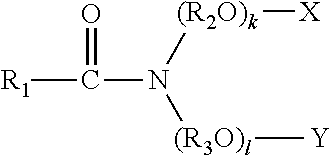Methods And Compositions For Hydrophobic Modification Of Oral Cavity Surfaces
a technology of oral cavity and composition, which is applied in the direction of packaging foodstuffs, transportation and packaging, and packaged goods types, etc., can solve the problems of tooth wear, increase in the consumption of acidic beverages and juices, and increase in the incidence and severity of dental erosion, so as to prevent caries, improve oral cavity appearance, and improve oral cavity appearance. , the effect of preventing tooth wear
- Summary
- Abstract
- Description
- Claims
- Application Information
AI Technical Summary
Benefits of technology
Problems solved by technology
Method used
Image
Examples
examples
[0137]The following examples further describe and demonstrate embodiments within the scope of the present invention. These examples are given solely for the purpose of illustration and are not to be construed as limitations of the present invention as many variations thereof are possible without departing from the spirit and scope.
example i
Dentifrice Compositions
[0138]Dentifrice compositions I-A-I-G according to the present invention and a comparative example I-H (without organophosphate) are shown below with ingredients in weight %. These compositions are made using conventional methods.
IngredientI-AI-BI-CI-DI-EI-FI-GI-HGlycerin10.0 30.0 20.0 20.0 —20.0 30.0 30.0 Sorbitol Solution30.0 ———43.7 ———Silica, dental type15.0 15.0 15.0015.0 22.0 15.0 15.0 15.0 NaF (USP) 0.24 0.24 0.24 0.24 0.24 0.24 0.24 0.24Potassium dodecyl phosphate (20% Soln)10.0 10.0 5.05.05.010.0 10.0 —Sodium dodeceth-1 phosphate (30% Soln)———— 3.33———Sodium acid pyrophosphate————4.2———Sodium saccharin0.5 0.500.50.50.50.5 0.500.5Sucralose———— 0.12———Sodium hydroxide (50% soln)————1.5———Carboxymethyl cellulose1.0———1.0———Carbomer 9560.30.50.50.50.20.5——Polyethylene oxide—2.02.02.00.22.0——Titanium dioxide 0.25 0.25 0.25 0.25 0.25 0.25——Flavor1.21.51.51.51.51.51.51.5Cetyl alcohol——————3.03.0Stearyl alcohol——————3.03.0Na lauryl sulfate (28% soln)——4.0—4.0...
example ii
Multi-Phase Oral Care Products
[0139]Stable oral care products comprising two or more distinct compositions each contained in physically separate compartments of e.g., a dentifrice dispenser are shown below. Each product contains at least a first composition (II-A1-II-A4) comprising one or more selected surface active organophosphate compounds and at least a second composition (II-B 1-II-B6) comprising an incompatible active such as stannous, zinc and calcium cations. Formulating the negatively charged organophosphate with a cation together in a single composition could result in precipitation, which could render both the cation and organophosphate compound inactive and compromise their intended benefits. Formulating these incompatible ingredients in separate phases allows optimum delivery to the oral cavity of both cation and organophosphate agent.
INGREDIENTSII-A1II-A2II-A3II-A4Sodium Fluoride0.240.24Sodium Laureth-1-phosphate (30% Soln)6.76.7Potassium Lauryl phosphate (40% w / w)5.05...
PUM
| Property | Measurement | Unit |
|---|---|---|
| water contact angle | aaaaa | aaaaa |
| temperature | aaaaa | aaaaa |
| water contact angle | aaaaa | aaaaa |
Abstract
Description
Claims
Application Information
 Login to View More
Login to View More - R&D
- Intellectual Property
- Life Sciences
- Materials
- Tech Scout
- Unparalleled Data Quality
- Higher Quality Content
- 60% Fewer Hallucinations
Browse by: Latest US Patents, China's latest patents, Technical Efficacy Thesaurus, Application Domain, Technology Topic, Popular Technical Reports.
© 2025 PatSnap. All rights reserved.Legal|Privacy policy|Modern Slavery Act Transparency Statement|Sitemap|About US| Contact US: help@patsnap.com



